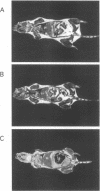Abstract
In extrahepatic tissues lipoprotein lipase (LPL) hydrolyzes triglycerides thereby generating FFA for tissue uptake and metabolism. To study the effects of increased FFA uptake in muscle tissue, transgenic mouse lines were generated with a human LPL minigene driven by the promoter of the muscle creatine kinase gene. In these mice human LPL was expressed in skeletal muscle and cardiac muscle, but not in other tissues. In proportion to the level of LPL overexpression, decreased plasma triglyceride levels, elevated FFA uptake by muscle tissue, weight loss, and premature death were observed in three independent transgenic mouse lines. The animals developed a severe myopathy characterized by muscle fiber degeneration, fiber atrophy, glycogen storage, and extensive proliferation of mitochondria and peroxisomes. This degree of proliferation suggests that FFA play an important role in the biogenesis of these organelles. Our experiments indicate that LPL is rate limiting for the supply of muscle tissue with triglyceride-derived FFA. Improper regulation of muscle LPL can lead to major pathological changes and may be important in the pathogenesis of some human myopathies. Muscle-specific LPL transgenic mouse lines will serve as a useful animal model for the investigation of myopathies and the biogenesis of mitochondria and peroxisomes.
Full text
PDF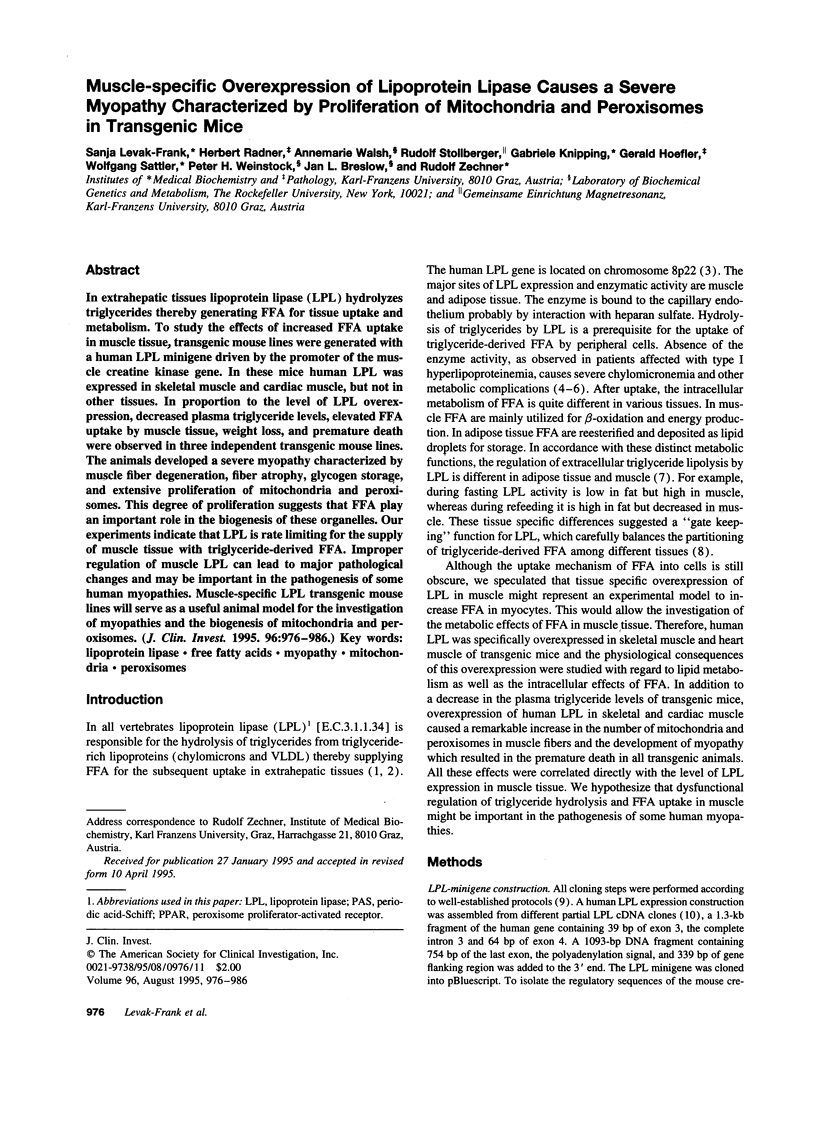
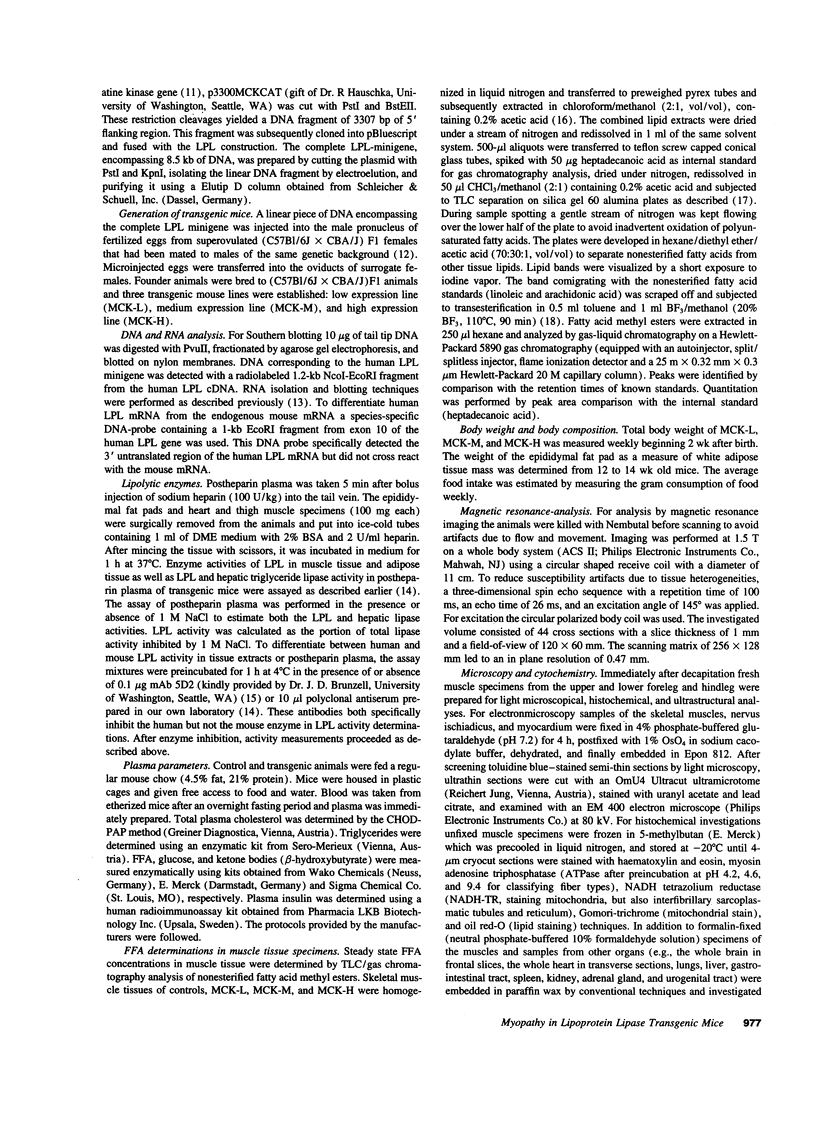
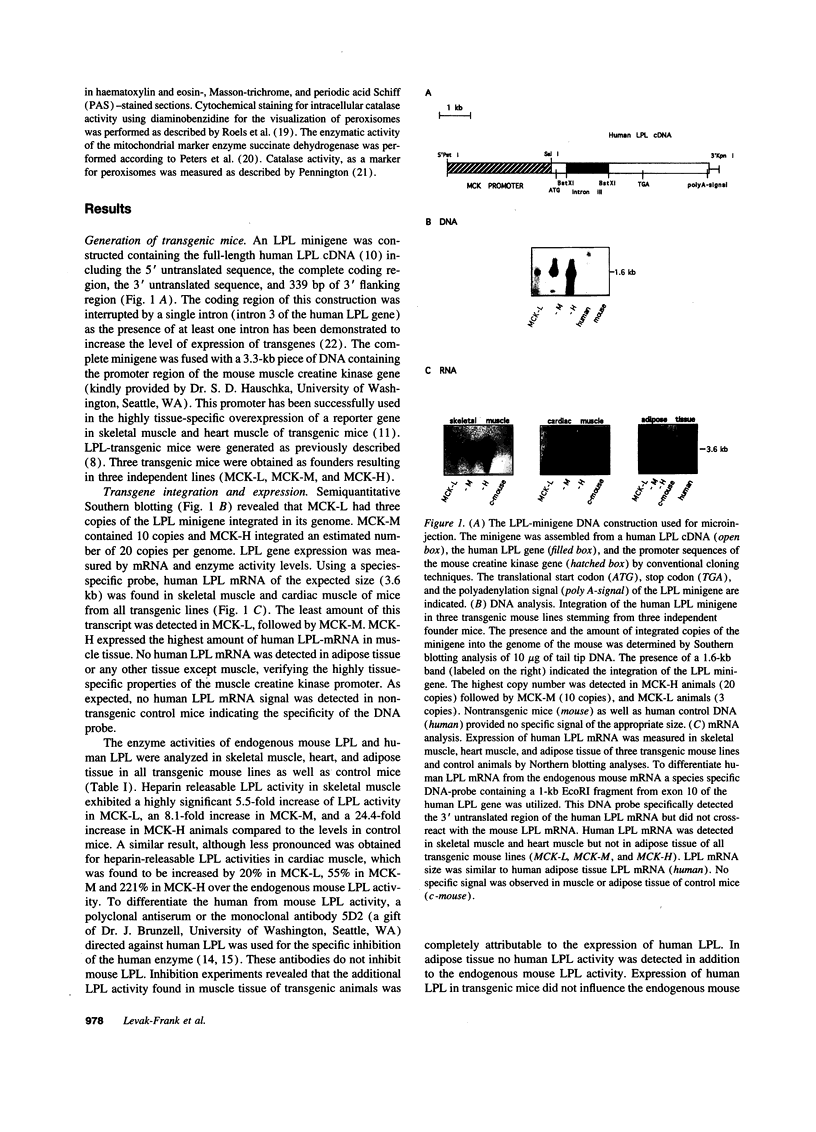
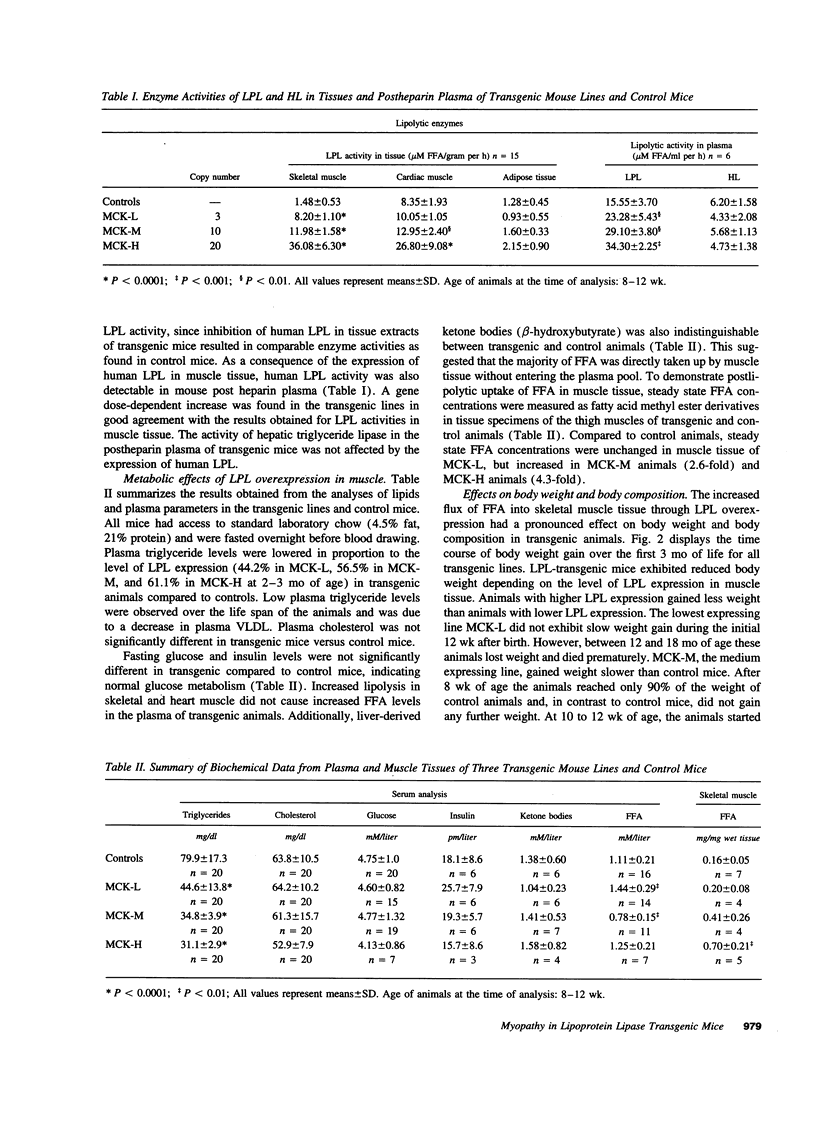
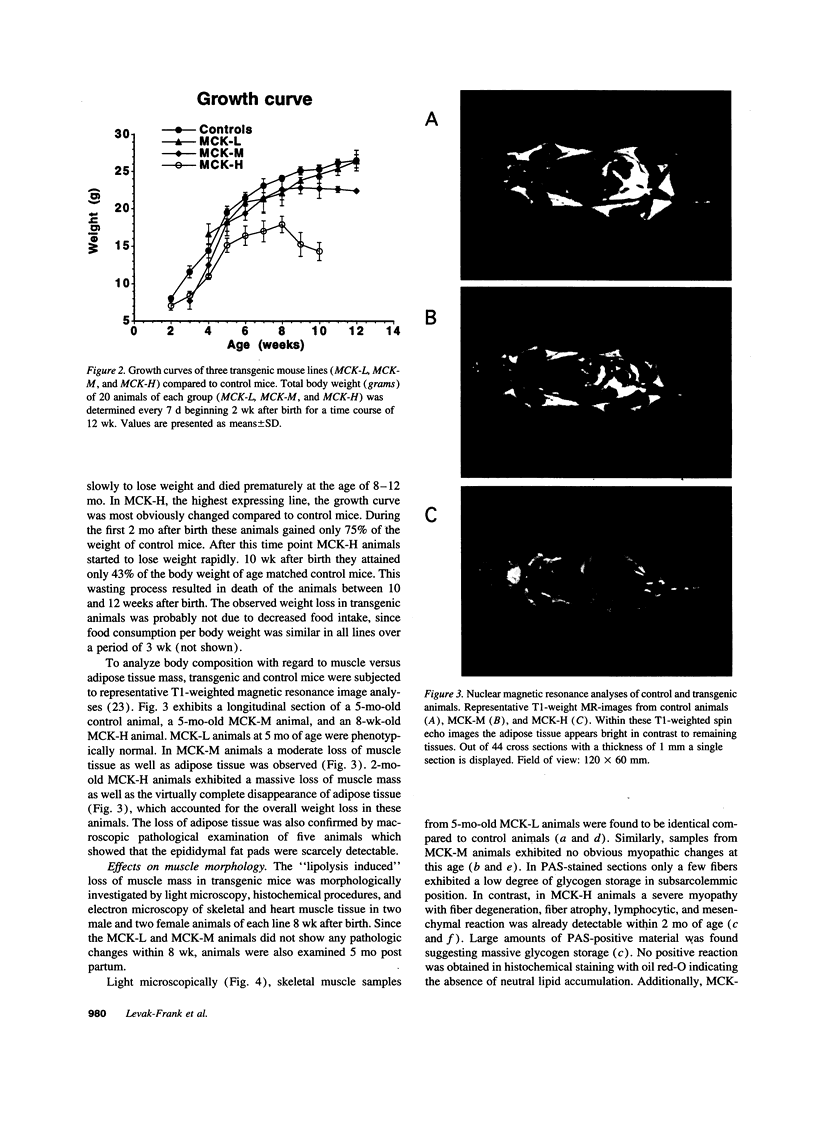
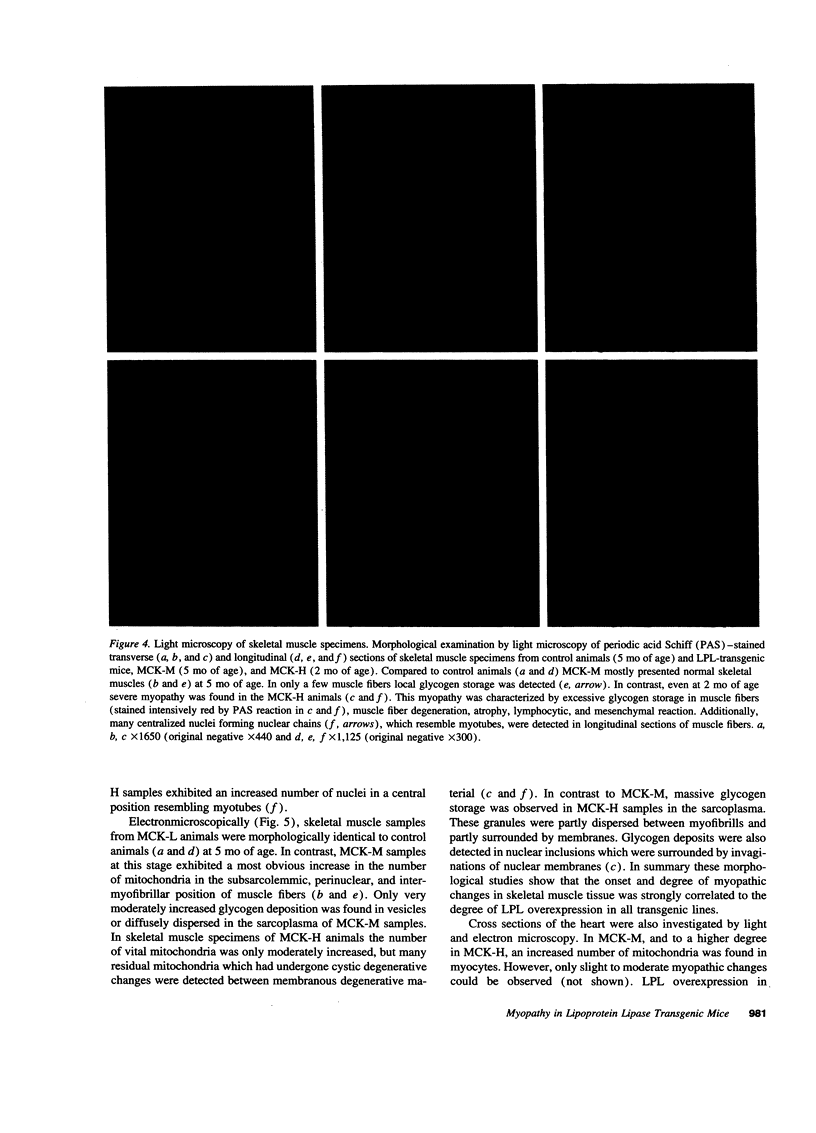
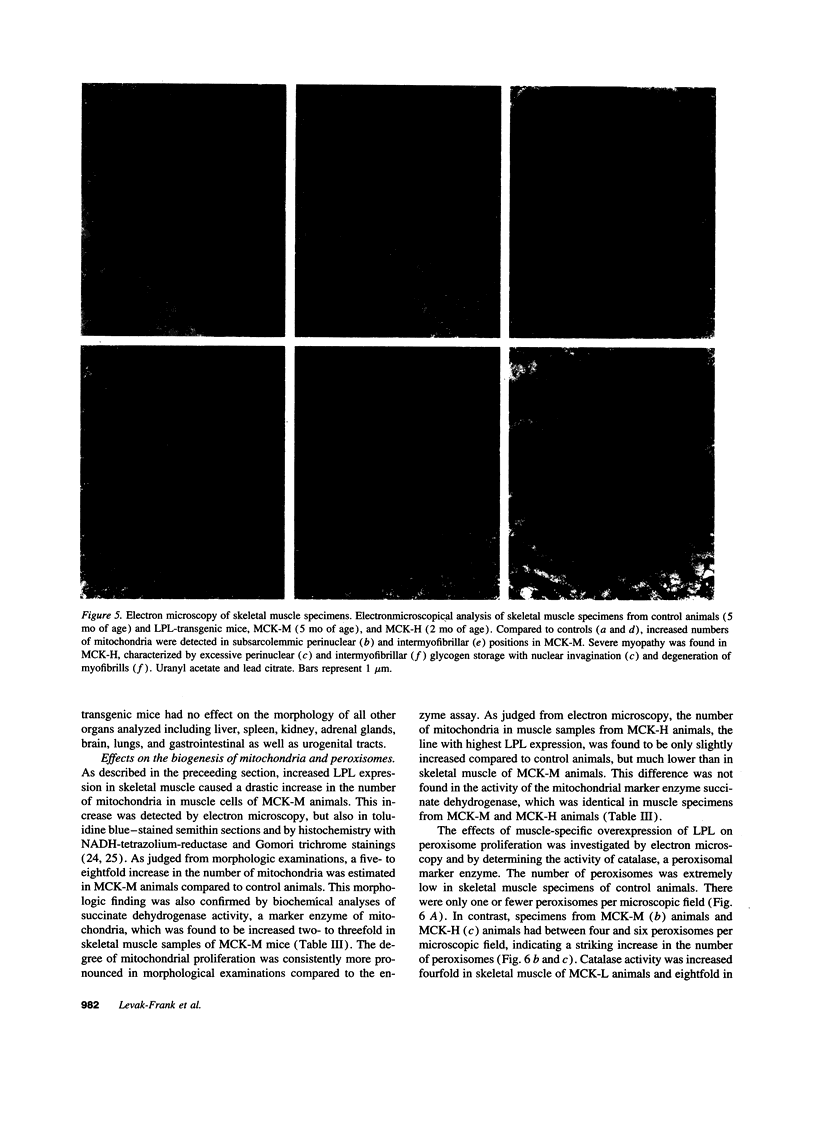
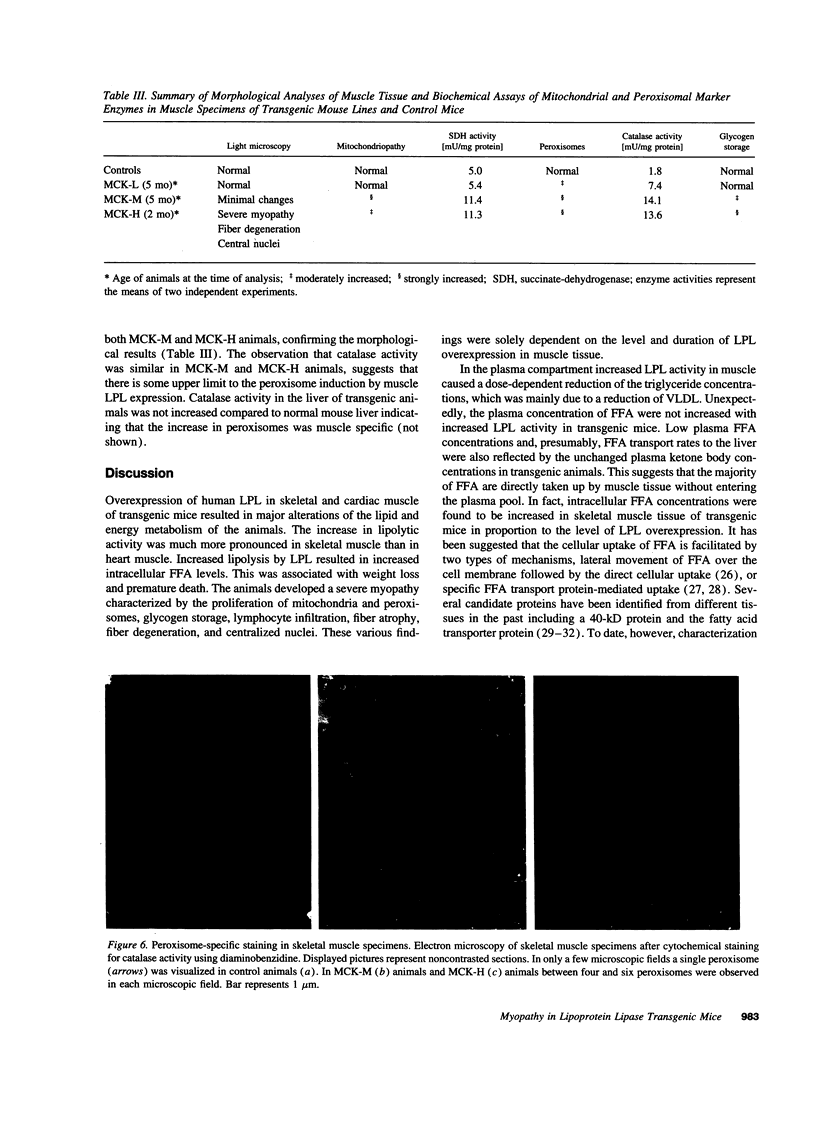
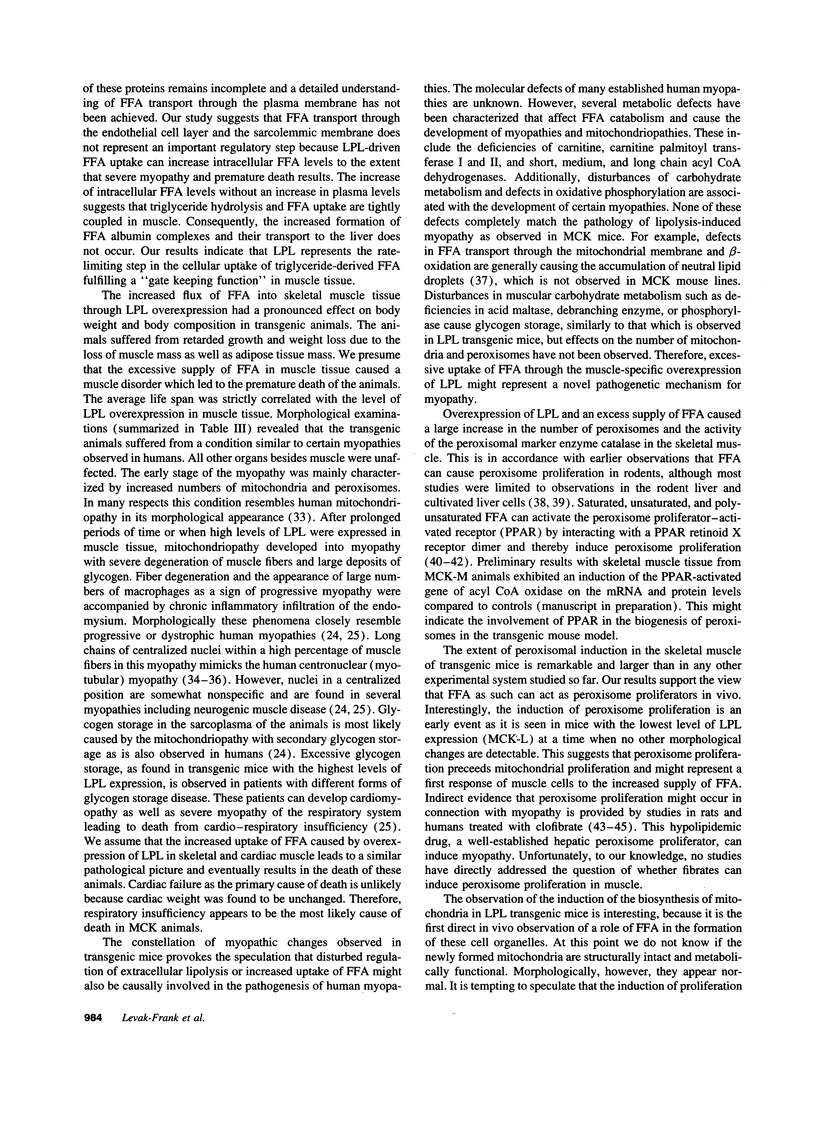
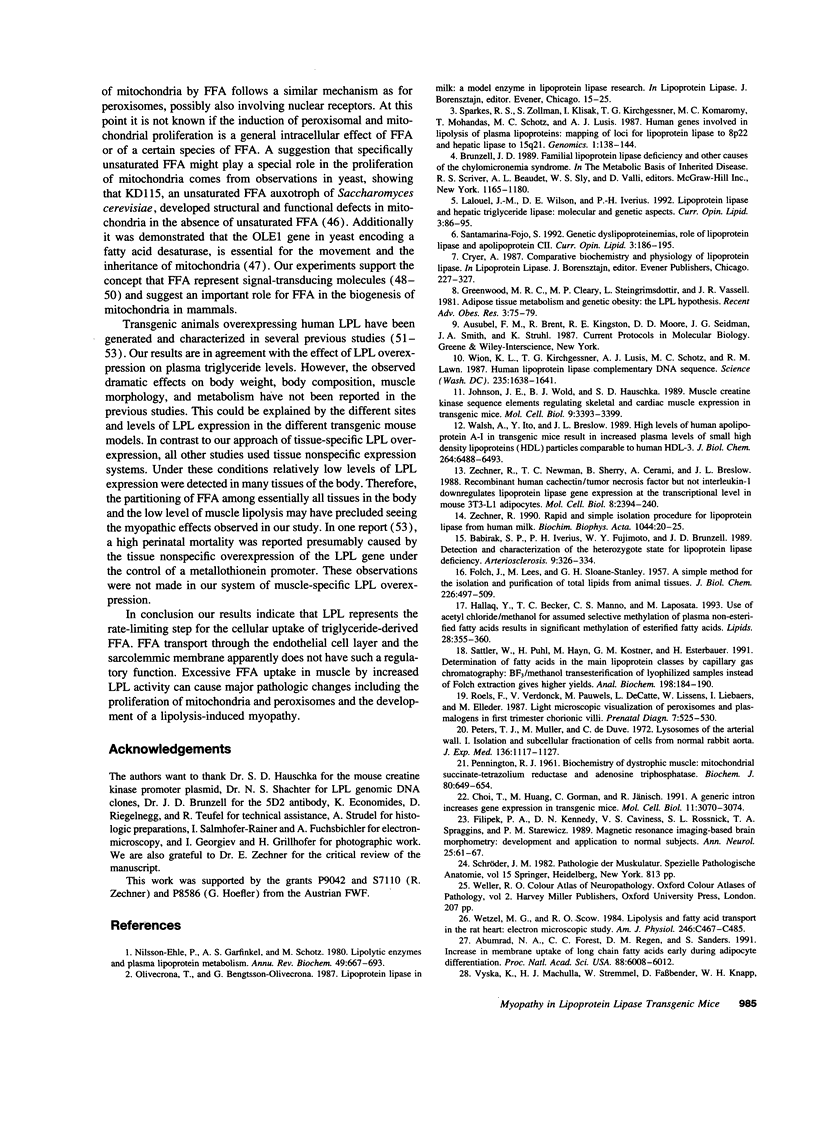
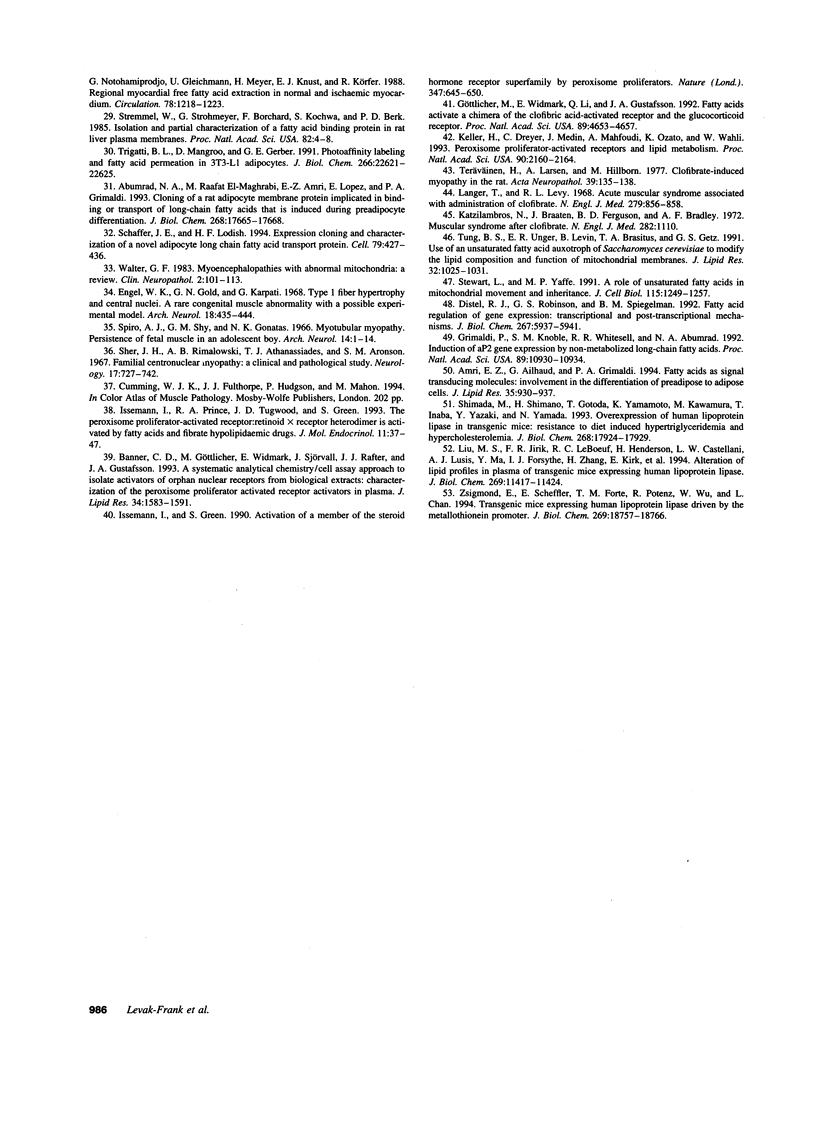
Images in this article
Selected References
These references are in PubMed. This may not be the complete list of references from this article.
- Abumrad N. A., Forest C. C., Regen D. M., Sanders S. Increase in membrane uptake of long-chain fatty acids early during preadipocyte differentiation. Proc Natl Acad Sci U S A. 1991 Jul 15;88(14):6008–6012. doi: 10.1073/pnas.88.14.6008. [DOI] [PMC free article] [PubMed] [Google Scholar]
- Abumrad N. A., el-Maghrabi M. R., Amri E. Z., Lopez E., Grimaldi P. A. Cloning of a rat adipocyte membrane protein implicated in binding or transport of long-chain fatty acids that is induced during preadipocyte differentiation. Homology with human CD36. J Biol Chem. 1993 Aug 25;268(24):17665–17668. [PubMed] [Google Scholar]
- Amri E. Z., Ailhaud G., Grimaldi P. A. Fatty acids as signal transducing molecules: involvement in the differentiation of preadipose to adipose cells. J Lipid Res. 1994 May;35(5):930–937. [PubMed] [Google Scholar]
- Babirak S. P., Iverius P. H., Fujimoto W. Y., Brunzell J. D. Detection and characterization of the heterozygote state for lipoprotein lipase deficiency. Arteriosclerosis. 1989 May-Jun;9(3):326–334. doi: 10.1161/01.atv.9.3.326. [DOI] [PubMed] [Google Scholar]
- Banner C. D., Göttlicher M., Widmark E., Sjövall J., Rafter J. J., Gustafsson J. A. A systematic analytical chemistry/cell assay approach to isolate activators of orphan nuclear receptors from biological extracts: characterization of peroxisome proliferator-activated receptor activators in plasma. J Lipid Res. 1993 Sep;34(9):1583–1591. [PubMed] [Google Scholar]
- Choi T., Huang M., Gorman C., Jaenisch R. A generic intron increases gene expression in transgenic mice. Mol Cell Biol. 1991 Jun;11(6):3070–3074. doi: 10.1128/mcb.11.6.3070. [DOI] [PMC free article] [PubMed] [Google Scholar]
- Distel R. J., Robinson G. S., Spiegelman B. M. Fatty acid regulation of gene expression. Transcriptional and post-transcriptional mechanisms. J Biol Chem. 1992 Mar 25;267(9):5937–5941. [PubMed] [Google Scholar]
- Engel W. K., Gold G. N., Karpati G. Type I fiber hypotrophy and central nuclei. A rare congenital muscle abnormality with a possible experimental model. Arch Neurol. 1968 Apr;18(4):435–444. doi: 10.1001/archneur.1968.00470340121011. [DOI] [PubMed] [Google Scholar]
- FOLCH J., LEES M., SLOANE STANLEY G. H. A simple method for the isolation and purification of total lipides from animal tissues. J Biol Chem. 1957 May;226(1):497–509. [PubMed] [Google Scholar]
- Filipek P. A., Kennedy D. N., Caviness V. S., Jr, Rossnick S. L., Spraggins T. A., Starewicz P. M. Magnetic resonance imaging-based brain morphometry: development and application to normal subjects. Ann Neurol. 1989 Jan;25(1):61–67. doi: 10.1002/ana.410250110. [DOI] [PubMed] [Google Scholar]
- Grimaldi P. A., Knobel S. M., Whitesell R. R., Abumrad N. A. Induction of aP2 gene expression by nonmetabolized long-chain fatty acids. Proc Natl Acad Sci U S A. 1992 Nov 15;89(22):10930–10934. doi: 10.1073/pnas.89.22.10930. [DOI] [PMC free article] [PubMed] [Google Scholar]
- Göttlicher M., Widmark E., Li Q., Gustafsson J. A. Fatty acids activate a chimera of the clofibric acid-activated receptor and the glucocorticoid receptor. Proc Natl Acad Sci U S A. 1992 May 15;89(10):4653–4657. doi: 10.1073/pnas.89.10.4653. [DOI] [PMC free article] [PubMed] [Google Scholar]
- Hallaq Y., Becker T. C., Manno C. S., Laposata M. Use of acetyl chloride/methanol for assumed selective methylation of plasma nonesterified fatty acids results in significant methylation of esterified fatty acids. Lipids. 1993 Apr;28(4):355–360. doi: 10.1007/BF02536323. [DOI] [PubMed] [Google Scholar]
- Issemann I., Green S. Activation of a member of the steroid hormone receptor superfamily by peroxisome proliferators. Nature. 1990 Oct 18;347(6294):645–650. doi: 10.1038/347645a0. [DOI] [PubMed] [Google Scholar]
- Issemann I., Prince R. A., Tugwood J. D., Green S. The peroxisome proliferator-activated receptor:retinoid X receptor heterodimer is activated by fatty acids and fibrate hypolipidaemic drugs. J Mol Endocrinol. 1993 Aug;11(1):37–47. doi: 10.1677/jme.0.0110037. [DOI] [PubMed] [Google Scholar]
- Johnson J. E., Wold B. J., Hauschka S. D. Muscle creatine kinase sequence elements regulating skeletal and cardiac muscle expression in transgenic mice. Mol Cell Biol. 1989 Aug;9(8):3393–3399. doi: 10.1128/mcb.9.8.3393. [DOI] [PMC free article] [PubMed] [Google Scholar]
- Katsilambros N., Braaten J., Ferguson B. D., Bradley R. F. Muscular syndrome after clofibrate. N Engl J Med. 1972 May 18;286(20):1110–1111. doi: 10.1056/nejm197205182862014. [DOI] [PubMed] [Google Scholar]
- Keller H., Dreyer C., Medin J., Mahfoudi A., Ozato K., Wahli W. Fatty acids and retinoids control lipid metabolism through activation of peroxisome proliferator-activated receptor-retinoid X receptor heterodimers. Proc Natl Acad Sci U S A. 1993 Mar 15;90(6):2160–2164. doi: 10.1073/pnas.90.6.2160. [DOI] [PMC free article] [PubMed] [Google Scholar]
- Langer T., Levy R. I. Acute muscular syndrome associated with administration of clofibrate. N Engl J Med. 1968 Oct 17;279(16):856–858. doi: 10.1056/NEJM196810172791604. [DOI] [PubMed] [Google Scholar]
- Liu M. S., Jirik F. R., LeBoeuf R. C., Henderson H., Castellani L. W., Lusis A. J., Ma Y., Forsythe I. J., Zhang H., Kirk E. Alteration of lipid profiles in plasma of transgenic mice expressing human lipoprotein lipase. J Biol Chem. 1994 Apr 15;269(15):11417–11424. [PubMed] [Google Scholar]
- Nilsson-Ehle P., Garfinkel A. S., Schotz M. C. Lipolytic enzymes and plasma lipoprotein metabolism. Annu Rev Biochem. 1980;49:667–693. doi: 10.1146/annurev.bi.49.070180.003315. [DOI] [PubMed] [Google Scholar]
- PENNINGTON R. J. Biochemistry of dystrophic muscle. Mitochondrial succinate-tetrazolium reductase and adenosine triphosphatase. Biochem J. 1961 Sep;80:649–654. doi: 10.1042/bj0800649. [DOI] [PMC free article] [PubMed] [Google Scholar]
- Peters T. J., Müller M., De Duve C. Lysosomes of the arterial wall. I. Isolation and subcellular fractionation of cells from normal rabbit aorta. J Exp Med. 1972 Nov 1;136(5):1117–1139. doi: 10.1084/jem.136.5.1117. [DOI] [PMC free article] [PubMed] [Google Scholar]
- Roels F., Verdonck V., Pauwels M., De Catte L., Lissens W., Liebaers I., Elleder M. Light microscopic visualization of peroxisomes and plasmalogens in first trimester chorionic villi. Prenat Diagn. 1987 Sep;7(7):525–530. doi: 10.1002/pd.1970070709. [DOI] [PubMed] [Google Scholar]
- Sattler W., Puhl H., Hayn M., Kostner G. M., Esterbauer H. Determination of fatty acids in the main lipoprotein classes by capillary gas chromatography: BF3/methanol transesterification of lyophilized samples instead of Folch extraction gives higher yields. Anal Biochem. 1991 Oct;198(1):184–190. doi: 10.1016/0003-2697(91)90526-y. [DOI] [PubMed] [Google Scholar]
- Schaffer J. E., Lodish H. F. Expression cloning and characterization of a novel adipocyte long chain fatty acid transport protein. Cell. 1994 Nov 4;79(3):427–436. doi: 10.1016/0092-8674(94)90252-6. [DOI] [PubMed] [Google Scholar]
- Sher J. H., Rimalovski A. B., Athanassiades T. J., Aronson S. M. Familial centronuclear myopathy: a clinical and pathological study. Neurology. 1967 Aug;17(8 Pt 1):727–742. doi: 10.1212/wnl.17.8.727. [DOI] [PubMed] [Google Scholar]
- Shimada M., Shimano H., Gotoda T., Yamamoto K., Kawamura M., Inaba T., Yazaki Y., Yamada N. Overexpression of human lipoprotein lipase in transgenic mice. Resistance to diet-induced hypertriglyceridemia and hypercholesterolemia. J Biol Chem. 1993 Aug 25;268(24):17924–17929. [PubMed] [Google Scholar]
- Sparkes R. S., Zollman S., Klisak I., Kirchgessner T. G., Komaromy M. C., Mohandas T., Schotz M. C., Lusis A. J. Human genes involved in lipolysis of plasma lipoproteins: mapping of loci for lipoprotein lipase to 8p22 and hepatic lipase to 15q21. Genomics. 1987 Oct;1(2):138–144. doi: 10.1016/0888-7543(87)90005-x. [DOI] [PubMed] [Google Scholar]
- Spiro A. J., Shy G. M., Gonatas N. K. Myotubular myopathy. Persistence of fetal muscle in an adolescent boy. Arch Neurol. 1966 Jan;14(1):1–14. doi: 10.1001/archneur.1966.00470070005001. [DOI] [PubMed] [Google Scholar]
- Stewart L. C., Yaffe M. P. A role for unsaturated fatty acids in mitochondrial movement and inheritance. J Cell Biol. 1991 Dec;115(5):1249–1257. doi: 10.1083/jcb.115.5.1249. [DOI] [PMC free article] [PubMed] [Google Scholar]
- Stremmel W., Strohmeyer G., Borchard F., Kochwa S., Berk P. D. Isolation and partial characterization of a fatty acid binding protein in rat liver plasma membranes. Proc Natl Acad Sci U S A. 1985 Jan;82(1):4–8. doi: 10.1073/pnas.82.1.4. [DOI] [PMC free article] [PubMed] [Google Scholar]
- Teräväinen H., Larsen A., Hillbom M. Clofibrate-induced myopathy in the rat. Acta Neuropathol. 1977 Aug 16;39(2):135–138. doi: 10.1007/BF00703319. [DOI] [PubMed] [Google Scholar]
- Trigatti B. L., Mangroo D., Gerber G. E. Photoaffinity labeling and fatty acid permeation in 3T3-L1 adipocytes. J Biol Chem. 1991 Nov 25;266(33):22621–22625. [PubMed] [Google Scholar]
- Tung B. S., Unger E. R., Levin B., Brasitus T. A., Getz G. S. Use of an unsaturated fatty acid auxotroph of Saccharomyces cerevisiae to modify the lipid composition and function of mitochondrial membranes. J Lipid Res. 1991 Jun;32(6):1025–1038. [PubMed] [Google Scholar]
- Vyska K., Machulla H. J., Stremmel W., Fassbender D., Knapp W. H., Notohamiprodjo G., Gleichmann U., Meyer H., Knust E. J., Körfer R. Regional myocardial free fatty acid extraction in normal and ischemic myocardium. Circulation. 1988 Nov;78(5 Pt 1):1218–1233. doi: 10.1161/01.cir.78.5.1218. [DOI] [PubMed] [Google Scholar]
- Walsh A., Ito Y., Breslow J. L. High levels of human apolipoprotein A-I in transgenic mice result in increased plasma levels of small high density lipoprotein (HDL) particles comparable to human HDL3. J Biol Chem. 1989 Apr 15;264(11):6488–6494. [PubMed] [Google Scholar]
- Walter G. F. Myoencephalopathies with abnormal mitochondria: a review. Clin Neuropathol. 1983;2(3):101–113. [PubMed] [Google Scholar]
- Wetzel M. G., Scow R. O. Lipolysis and fatty acid transport in rat heart: electron microscopic study. Am J Physiol. 1984 May;246(5 Pt 1):C467–C485. doi: 10.1152/ajpcell.1984.246.5.C467. [DOI] [PubMed] [Google Scholar]
- Wion K. L., Kirchgessner T. G., Lusis A. J., Schotz M. C., Lawn R. M. Human lipoprotein lipase complementary DNA sequence. Science. 1987 Mar 27;235(4796):1638–1641. doi: 10.1126/science.3823907. [DOI] [PubMed] [Google Scholar]
- Zechner R., Newman T. C., Sherry B., Cerami A., Breslow J. L. Recombinant human cachectin/tumor necrosis factor but not interleukin-1 alpha downregulates lipoprotein lipase gene expression at the transcriptional level in mouse 3T3-L1 adipocytes. Mol Cell Biol. 1988 Jun;8(6):2394–2401. doi: 10.1128/mcb.8.6.2394. [DOI] [PMC free article] [PubMed] [Google Scholar]
- Zechner R. Rapid and simple isolation procedure for lipoprotein lipase from human milk. Biochim Biophys Acta. 1990 May 1;1044(1):20–25. doi: 10.1016/0005-2760(90)90213-h. [DOI] [PubMed] [Google Scholar]
- Zsigmond E., Scheffler E., Forte T. M., Potenz R., Wu W., Chan L. Transgenic mice expressing human lipoprotein lipase driven by the mouse metallothionein promoter. A phenotype associated with increased perinatal mortality and reduced plasma very low density lipoprotein of normal size. J Biol Chem. 1994 Jul 22;269(29):18757–18766. [PubMed] [Google Scholar]





